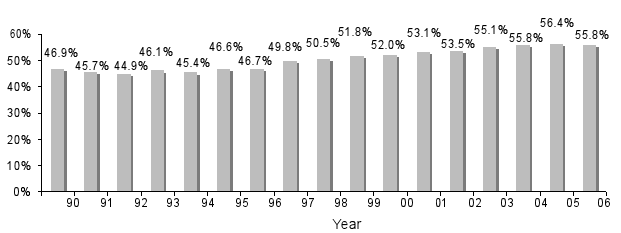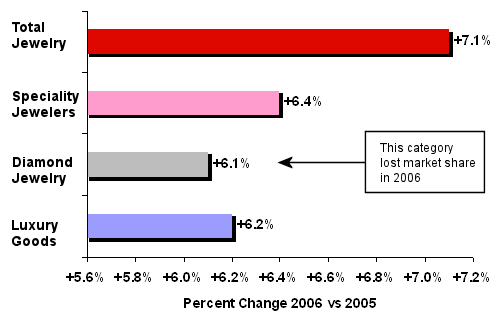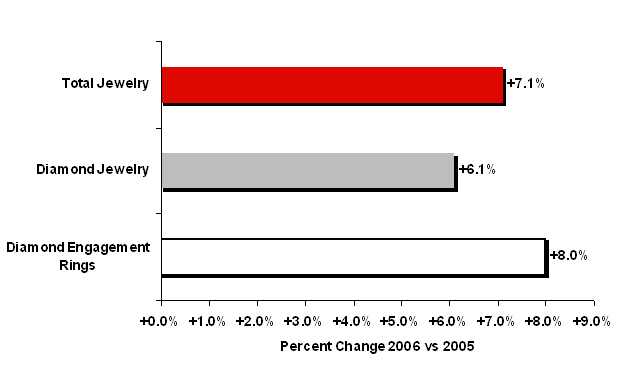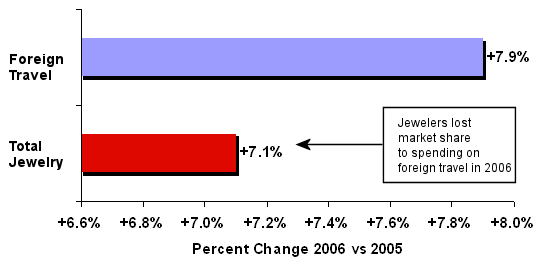IDEX Online Research: Diamond Jewelry Loses Market Share in 2006
April 12, 07
After gaining market share with U.S. jewelers for the past eleven years, diamond jewelry lost market share in 2006. Newly released statistics from the Diamond Information Center (DIC) and the U.S. Department of Commerce confirm that diamond jewelry sales represented 55.8 percent of a typical jeweler’s sales in 2006, down from 56.4 percent in 2005.
The graph below illustrates the trends in diamond jewelry market share in the U.S. since 1990.
| Diamond Jewelry Diamond Share |
In 2006, total U.S. jewelry sales were $63.1 billion, according to the U.S. Department of Commerce, up 7.1 percent from the prior year. Diamond jewelry sales were $35.2 billion, according to the Diamond Information Center (DIC), up 6.1 percent from the prior year’s revised $33.2 billion. Due to a change in research methodology by the DIC, certain historical numbers were revised, including total diamond jewelry sales for 2005. IDEX Online Research analysis is based on revised DIC numbers, where available.
Long-Term Growth Trend Positive for Diamond Jewelry
Over the long term, diamond jewelry has become a much more important category for U.S. jewelers. In the early 1990s, it represented about 45 percent of their total sales. Due largely to heavy spending by De Beers on retail advertising as well as development of diamond jewelry promotions such as the Three-Stone Ring, Journey, and others, diamond jewelry sales now represent just over 55 percent of a typical retail jeweler’s sales.
Typically, chain jewelers generate more sales from diamond jewelry than independent specialty jewelers, as the following statistics indicate:
- Independent specialty jewelers in America generate about 48 percent of their total sales from diamonds and diamond jewelry, according to the Jewelers of America Cost of Doing Business Survey for 2005. This sales mix is down from 2004’s sales mix which showed that independent specialty jewelers generated 50 percent of their sales from diamonds and diamond jewelry. Thus, it is no surprise that the latest figures from the Diamond Information Center also show a modest decline in diamond jewelry market share.
- Some large chain jewelers generate as much as 70 percent or more of their sales from diamond jewelry. For example, Sterling Jewelers’ diamond sales mix rose to 72 percent of total sales in 2006, up from 71 percent in 2005. Whitehall generated 67 percent of its sales from diamonds in 2005. Zale does not report its diamond sales mix, but about 45 percent of its sales are bridal related, so we believe that its revenues from diamond jewelry are well in excess of 60 percent of total sales.
Diamond Sales Growth Strong, but Less than Total Jewelry Sales Growth
Diamond jewelry sales in the U.S. rose by 6.1 percent in 2006. Unfortunately, that growth rate lagged the overall growth rate – +7.1 percent – of all jewelry sales in the U.S. last year. This means that diamond jewelry lost market share in 2006 versus other jewelry categories.
Further, the growth of the diamond jewelry category also lagged the rate of growth of specialty jewelers’ sales in America, who account for nearly half (48 percent) of all jewelry sold. Specialty jewelers’ sales grew by 6.4 percent in 2006, indicating that diamond jewelry lost market share among retailers in this key distribution channel.
Finally, diamond jewelry sales lost a modest amount of market share in the luxury goods market in America. Sales at mall-based luxury goods retailers rose by 6.2 percent in 2006, according to the International Council of Shopping Centers.
The graph below illustrates the growth rate of various jewelry categories in the U.S. in 2006 compared to sales of all luxury goods.
| U.S. Market - Spending Trends 2006 |
Diamond Engagement Rings Take Market Share
While diamond jewelry lost market share in 2006, American consumers clearly like their diamond engagement rings to be big, bold, and expensive. Not only did the average ticket rise sharply for diamond engagement rings in 2006, but total spending on diamond engagement rings spiked by 8 percent to $6.2 billion from a revised $5.7 billion in 2005. This large sales gain of 8 percent trumped the gains for every other major jewelry category as well as luxury sales and total U.S. retail sales.
The graph below illustrates how spending on diamond engagement rings in 2006 compared favorably to other categories.
| U.S. Market - Spending Trends 2006 |
Travel Spending Accelerates
Diamond marketers contend that the greatest competition that the diamond industry faces is from the travel industry. Do American shoppers want the glitz of foreign travel or the glitter of a diamond? In 2006, U.S. American consumers answered that question clearly: they stepped up their spending on foreign travel by nearly 8 percent over 2005’s spending levels, well ahead of the 7 percent increase in spending for jewelry and far ahead of their 6 percent increase in spending for diamonds and diamond jewelry. In 2006, Americans spent about $108 billion on foreign travel or 71 percent more than they spent on jewelry.
The graph below illustrates consumers’ spending on jewelry versus foreign travel.
| U.S. Market - Spending Trends 2006 |
Jewelry Lost Market Share to Other Retail Categories
Unfortunately, the U.S. jewelry industry – diamonds, all jewelry, and all luxury goods – lost market share to total U.S. retail sales (ex-autos and food). Total U.S. retail sales (ex-autos and food) rose by 7.2 percent in 2006, according to the U.S. Department of Commerce. Total jewelry industry sales were up by 7.1 percent, and diamond sales were up by 6.1 percent.
The graph below illustrates the growth of all jewelry and diamond jewelry to all U.S. retail sales.
| U.S. Market - Spending Trends 2006 |



